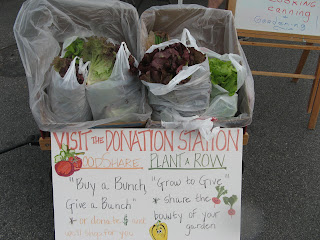 Join local farmers, shoppers and volunteers on September 25th from 8 am – 12 noon for the Triangle Farmer Foodshare Challenge—a one-day effort to raise over 4,000 pounds of fresh local food for hungry people in the Triangle!
Join local farmers, shoppers and volunteers on September 25th from 8 am – 12 noon for the Triangle Farmer Foodshare Challenge—a one-day effort to raise over 4,000 pounds of fresh local food for hungry people in the Triangle!The Western Wake Farmers’ Market (WWFM), Carrboro Farmers’ Market, Durham Farmers’ Market, and the S. Estes Farmers’ Market in Chapel Hill are joining together in this effort to provide fresh, local food for the food insecure in the Triangle and to help support area farmers.
Partner organization, Inter-Faith Food Shuttle, will pick up donations at WWFM at the close of market and deliver foods right away to pantries, shelters and others who can use these foods immediately!
How can you participate? It's easy.
1) Buy market foods for your family, and buy some extra for the Donation Station at market.
2) Or you can donate cash at the Donation Stations, and volunteers will shop the vendors' tents for foods for the donation boxes.
3) Or, if you simpley cannot get to market on Saturday, donate donate online at the Abundance Foundation.
Each market hopes to collect 1,000 pounds of food. So come on out and get some great local food for your family, and buy some extra for families in our area that just don't get enough fresh fruits and vegetables!
WWFM's Goal: Healthy Food for All
WWFM has collected 2,975 pounds of local food for donations since April 3. Way to go WWFM shoppers! With your generosity, hungry people have access to locally grown and hand-crafted foods that are healthy, rather than process.
“So often food drives involve highly processed, unhealthy foods. With Foodshare, we can help feed hungry families with seasonal produce, whole grain breads and other healthy foods from the market,” said Juliann Zoetmulder, WWFM president. “We’re really excited to be part of this challenge, and we’re continually amazed by the generosity of our shoppers, vendors and volunteers to make this happen. We are looking forward to a great turn-out!”
The Need for Fresh Food and Local Farms
“Despite some great efforts across the state, North Carolina is not measuring up,” said Diane Beth, Nutrition Unit Manager/N.C. Fruit & Vegetable Nutrition Coordinator, N.C. Division of Public Health. The report on ‘State-Specific Trends in Fruit and Vegetable Consumption Among Adults -- United States, 2000-2009’ was released by the U.S. Centers for Disease Control and Prevention (CDC) in the September 9th edition of the Morbidity and Mortality Weekly Report.
This report provides the most recent fruit and vegetable consumption rates along with trends across the decade to assess whether North Carolina residents, along with adults across America, met the Healthy People 2010 fruit and vegetable goals. Fresh fruit and vegetables are a fundamental need for a healthy life. Community efforts like the Farmer Foodshare Challenge can help get more fruits and vegetables to the tables of our state’s citizens.”
Between 2002 and 2007, NC lost 164 farms and over 500,000 acres of farmland; the percentage of farms reporting net losses grew from 54% to 58%. Local markets, by contrast, are a growing industry. The value of direct sales to consumers by NC farmers increased almost 60 percent from 2002 to 2007, and the number of farms selling directly to consumers increased by 21% (data: NASS Census of Agriculture).
“Farmers’ markets are one of the most direct ways that N.C. citizens can support their local farmers,” said Freda Butner, Nutrition Marketing Specialist, N.C. Department of Agriculture & Consumer Services. “Events like Farmer Foodshare Challenge help communities support their local farmers and enhance access to fresh food for those who may not otherwise get to enjoy fresh produce often.”
Each farmers’ market will donate to local charities, including Inter-Faith Council for Social Services, the Inter-Faith Food Shuttle, TABLE, Urban Ministries, as well as local senior centers and churches that feed the hungry.
Volunteers from each market, as well as UNC’s Fair.Local.Organic. organization Inter-Faith Food Shuttle and the Society of St. Andrew, will help to collect and deliver the food.
Between 2002 and 2007, NC lost 164 farms and over 500,000 acres of farmland; the percentage of farms reporting net losses grew from 54% to 58%. Local markets, by contrast, are a growing industry. The value of direct sales to consumers by NC farmers increased almost 60 percent from 2002 to 2007, and the number of farms selling directly to consumers increased by 21% (data: NASS Census of Agriculture).
“Farmers’ markets are one of the most direct ways that N.C. citizens can support their local farmers,” said Freda Butner, Nutrition Marketing Specialist, N.C. Department of Agriculture & Consumer Services. “Events like Farmer Foodshare Challenge help communities support their local farmers and enhance access to fresh food for those who may not otherwise get to enjoy fresh produce often.”
Each farmers’ market will donate to local charities, including Inter-Faith Council for Social Services, the Inter-Faith Food Shuttle, TABLE, Urban Ministries, as well as local senior centers and churches that feed the hungry.
Volunteers from each market, as well as UNC’s Fair.Local.Organic. organization Inter-Faith Food Shuttle and the Society of St. Andrew, will help to collect and deliver the food.
Join us at market on Sept. 25, 8 am-12 pm, and give generously to help us collect and donate 1,000 pounds of food! Thank you!

No comments:
Post a Comment